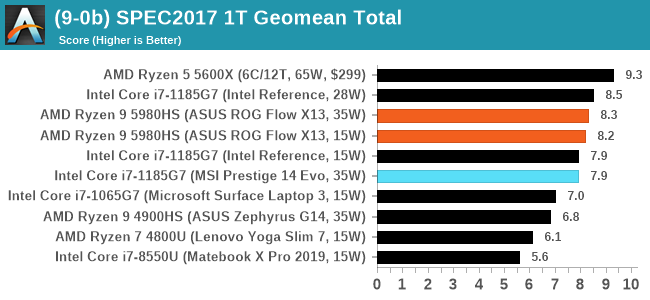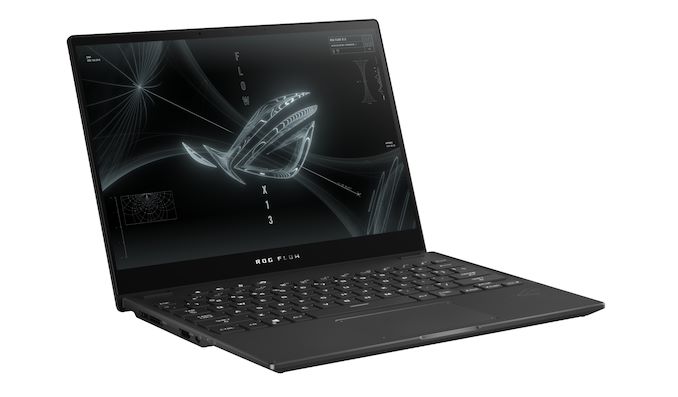AMD Ryzen 9 5980HS Cezanne Review: Ryzen 5000 Mobile Tested
by Dr. Ian Cutress on January 26, 2021 9:00 AM EST- Posted in
- CPUs
- AMD
- Vega
- Ryzen
- Zen 3
- Renoir
- Notebook
- Ryzen 9 5980HS
- Ryzen 5000 Mobile
- Cezanne
Focusing on Premium Experiences
The issue with AMD’s notebook strategy through the 2010s was that most users saw the brand as a budget implementation, with low performance and low specifications. Both AMD and its OEM partners were complicit in assisting this projection, using 1366x768 TN screens and slow mechanical hard drives. There were a number of negative feedback loops preventing a nice AMD mobile system from hitting the market, and the only key design wins were from mass corporate sales. With the launch of the first Ryzen Mobile towards the end of the decade, AMD finally had a performance product worthy of attention, and the company has had a steady improvement generation-on-generation, convincing its OEM partners to come along and take advantage of the performance uplift for their customers.
AMD’s historic lows in that 2010 decade were performance, specifications, and battery life. With Ryzen 4000 Mobile, from last generation, AMD had a product that could dispel all those assumptions, and we saw critical acclaim put upon devices like the Lenovo Slim 7 Yoga, and the ASUS Zephyrus G14. From our review of the new generation today, Ryzen 5000 Mobile, the whole strategy that AMD is playing has finally come into focus.
AMD stated that the new generation Ryzen 5000 Mobile processors were in the lab and up-and-running only two months after Ryzen 4000 Mobile launched. AMD made both sets of processors pin-compatible, allowing OEM partners to build designs that could be used for either processor family. The key here that I’ve realized is that AMD’s ultimate goal with these was to build a strong Ryzen 5000 Mobile family, and Ryzen 4000 Mobile was an option for partners to take baby steps, but the main goal was Ryzen 5000, with Zen 3. AMD’s statement of already having over 150+ system designs in the works with Ryzen 5000 Mobile, another +50% over the previous generation, along with this strategy of having a regular predictable cadence of products through re-use of different hardware elements showcases why Ryzen 5000 Mobile is important to the company. With AMD’s recent supply issues as well, we’re of the opinion that AMD has been stockpiling these Ryzen 5000 Mobile processors in order to enable a strong Q1 and Q2 launch of the platform with stock for all OEMs.
What we tested today is one of the AMD flagships for launch, the Ryzen 9 5980HS inside the ASUS ROG Flow X13. This is a sub-16mm ultraportable gaming laptop with a mid-range discrete GPU installed, an impressive 4K 16:10 Pantone certified IPS display, 32GB LPDDR4X memory and a 1 TB NVMe SSD. It also has an executive feel and design, indicating that both AMD and ASUS want to take this platform to its most premium customers. We’re leaving a full review of the laptop itself for a later date, let us focus on the performance of the processor inside.
The jump from Zen 2 to Zen 3 in the mobile space for AMD is more than just putting in the new cores. The cache adjustment from a split 4+4 MB L3 cache to a unified 16 MB L3 cache enables a better effective latency and less reliance on constantly going out to main memory – AMD is also aggressive on the L3 prefetching policies to drive performance. We can see that the single 8-core CCX has low core-to-core communication latency showcasing that enthusiast level workloads will benefit in more ways than one.
AMD is also piling on improvements to help with power, such as enabling different per-core voltage levels and a more efficient memory controller. Per-core voltage control is something that every modern CPU has to have (or at least islands of CPUs) in order to get the best battery performance. AMD is pairing this with its CPPC2 support, and users will benefit from very quick idle-to-turbo performance for immediate responsiveness.

For our benchmark suite, almost all of our benchmarks show an uplift for the new Ryzen 5000 Mobile series, some considerably so: our compile benchmark is +12%, Corona rendering is +18%, Dolphin emulation +17%, NAMD +8%, Blender +6%. To our surprise our SPEC2006 1T benchmark is +32%, accelerated considerably by the 16 MB L3 cache, but also because these CPUs also support a higher instantaneous power turbo modes than the previous generation. This enables some competitive performance numbers against Intel’s Tiger Lake platform in single thread focused tests (AMD wins on multithread quite easily).
All of these core updates, as well as design wins enabling better hardware under the hood, put AMD’s Ryzen 5000 Mobile series in good stead to power a generation of machines especially as more and more of us work from home. When Intel was in a period of high demand through 2018 and 2019, Intel focused on premium solutions to make the most revenue - Intel’s financials last week showed that the company was selling more and more education-focused low-end notebooks and Chromebooks, now that demand had reduced. We can apply something similar to AMD's current situtation - AMD’s silicon is in high demand for 2021, and so AMD’s target this year would appear to be more mid-range, premium commercial, and enthusiast machines. To reaffirm this, AMD has also promised that we will see notebooks this year paired with the most powerful mobile graphics cards, enabling high-performance gamers to move to AMD. No doubt we will have a number pass through our hands through the year, especially as they hit the shelves starting February.












218 Comments
View All Comments
andychow - Tuesday, January 26, 2021 - link
Ok, so the Ryzen 7 5800U is a 16 threaded CPU that Turbos to 4400 Mhz, and only uses 15 Watts. Oh, and btw, it also has a 2000 Mhz GPU for no extra power cost?Spoelie - Wednesday, January 27, 2021 - link
There are few mistakes in your assertion- the 15w number is only guaranteed at the base clocks of 1900mhz, not the 4400mhz turbo
- the cpu & gpu clocks mentioned in the specifications are their respective maximum clocks, not their typical clocks in a mixed workload. So the 2ghz GPU clock won't happen together with a 4.4ghz CPU clock and certainly not in the 15w power envelope
Deicidium369 - Wednesday, January 27, 2021 - link
Watts are different on AMDs - something something roadhouse!Spunjji - Thursday, January 28, 2021 - link
Intel have a "15W" CPU that needs ~30W to perform at the advertised levels, but sure, something something AMDschujj07 - Friday, January 29, 2021 - link
What Intel uses for TDP is even worse. AMD: We have a 65W TDP chip but max full package draw is 88W. Intel: We have a 125W TDP chip, but we can allow it to go to 250W for 56 seconds in an absolute stock operation. However, motherboard manufacturers can all for unlimited turbo settings and that is the SOP for those motherboards. Therefore you actually have a 250W TDP chip but we will tell you it is 125W.Spunjji - Thursday, January 28, 2021 - link
"Oh, and btw, it also has a 2000 Mhz GPU for no extra power cost"What do you mean "no extra power cost"? They covered how it gets the faster GPU cocks in the review: partly improved efficiency in the GPU, but mostly from improved efficiency on the CPU side allowing more TDP to be used by the GPU.
hanselltc - Tuesday, January 26, 2021 - link
Where efficiency?R3MF - Tuesday, January 26, 2021 - link
Does this 5xxx mobile APU offer 8x PCIe lanes or 16x?And does it support PCIe3 or PCIe4?
neblogai - Tuesday, January 26, 2021 - link
x8, pcie 3.0 on laptops. Should only affect performance by 2-3% with a mobile 3080, as long as resolution is not 4K, or 3080 is the 16GB version.vladx - Wednesday, January 27, 2021 - link
Why would someone buy RTX 3080 laptop and not use it for 4k?